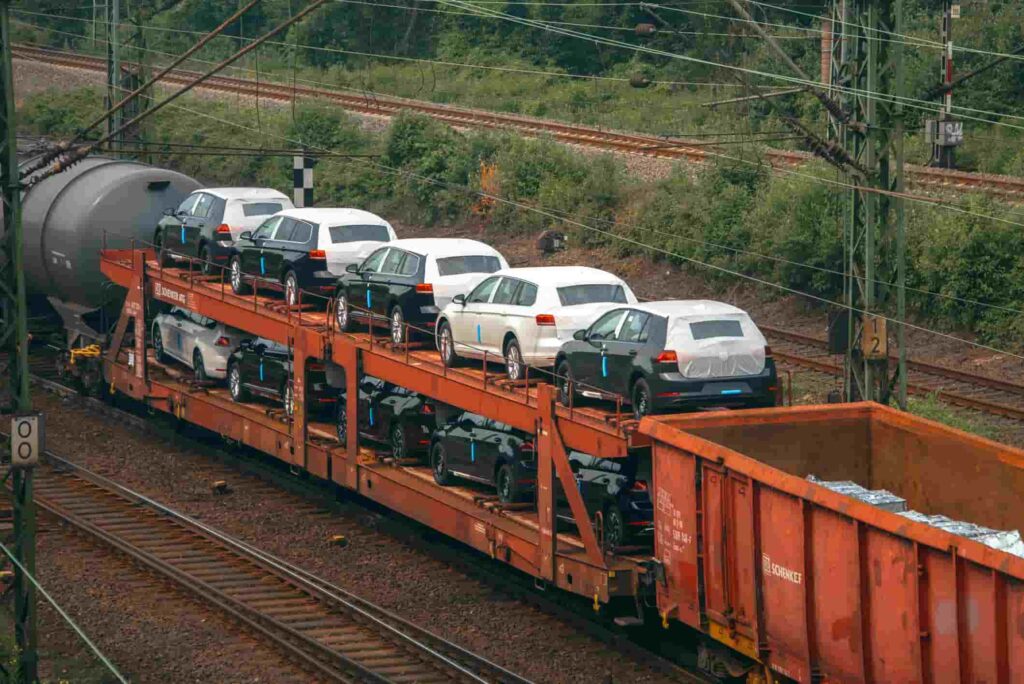Shipping cars by train is becoming an increasingly viable and attractive option for transportation. With the recent advances in train infrastructure, rail transport is now more efficient, cost-effective, and environmentally friendly than ever before.
It also offers a much safer option than other methods such as trucks or ships, as the cargo remains on the same vehicle throughout its journey.
Benefits Of Rail Transport:
- Using a train to ship a car may seem like an unusual choice, but it can actually be a great way to transport a vehicle. Trains offer several benefits over other methods of transportation, including efficiency, reduced emissions, and safety.
- One of the primary advantages of using a train to transport a vehicle is its efficiency. Because trains are able to travel at a high speed, they usually require less time to complete a journey than other shipping methods. That means the car will arrive at its destination quicker, meaning less time spent in transit.
- Railways provide an efficient and reliable means of moving cars from one place to another. Not only can they move large quantities of vehicles at once, they also reduce the time of transit compared to other forms of transportation.
- Trains also offer reduced emissions compared to other methods of transport. Due to their size and weight, they require less energy to move, making them a more eco-friendly option.
- Additionally, rail transport is much safer than other methods, as the secure nature of the railcars ensures that the car will be well-protected during the journey. Additionally, cars on trains are monitored and tracked, providing an added layer of security.
How Car Shipping By Train Works?
Transporting a vehicle by train is a safe and cost-effective way to move a car, truck, or other vehicle across the country or around the world. To do so, specialized railcars with included tie-downs and special safety measures are used to keep the vehicle secure during the transport process.
This type of car transport is similar to shipping via trucks, but with significant benefits over traditional methods. The load is light enough that the train can move the car with much greater efficiency, reducing the time and cost of shipping.
Plus, the emissions are significantly lower when transporting via rail, making it a much more environmental-friendly option.
Factors Influencing The Cost And Logistics Of Car Transport Via Train.
Shipping a car by train has the potential to be cost-effective, depending on the route and other considerations. Depending on the route, you may need to pay for specialized railcars with ramps to load and unload the car onto the train, which can add to the cost.
Additionally, the logistics of loading and unloading the car on the train can be time-consuming and complicated. For example, if the train doesn’t have access to the shipping destination, you’ll need to arrange to have the car delivered from the train station.
Moreover, the availability of trains can vary widely. For instance, in most states, trains may not be available at all or may be limited to certain times of the day or week. All of these factors influence the cost and logistics of car transport via train.
Considerations When Choosing Train Transport Over Other Methods.
When deciding on a car shipping method, there are several factors to consider. Train transport can be an attractive option for those looking for a cost-effective, safe and environmentally friendly way of shipping their vehicle. The cost of transporting a vehicle by train tends to be much lower than other methods, as trains can carry more vehicles at one time.
Trains also provide greater safety, as there is less risk of damage to the vehicle due to bad weather or accidents. Additionally, transporting vehicles by train reduces emissions, as trains are more energy efficient and run on electricity rather than combustible fuels.
However, train transport may not be the best option in all cases, as it can be more expensive for shorter distances, and takes longer than other methods.
Another consideration is the availability of railcars for car transportation in the area, as some railroads do not offer specialized cars for this purpose. It is also important to factor in the time frame of delivery. Trains generally take longer to transport vehicles than other methods, so it is important to consider the urgency of the shipment when choosing a method.
Comparison Between Train Transport And Other Shipping Methods, Such As Trucks And Ships.
When it comes to transport of vehicles, there are numerous options available. Many people choose traditional methods, such as shipping a car by truck or ship. While these methods can often work well, they often come with many drawbacks and drawbacks that make them less attractive. Train transport, however, offers many distinct advantages.
For starters, rail transport is much more efficient than trucks, ships, or airplanes. This is because trains can carry a large number of vehicles in a single trip and can reach many destinations quickly. Additionally, trains are much safer than other methods, as their cargo is well secured and is less likely to be damaged or lost during transport. When it comes to emissions, trains are much more eco-friendly than other methods, as they are powered mainly by electricity.
What’s more, the cost of transporting vehicles by train is often much lower than by truck or ship. This is due to the fact that trains require less fuel than other methods and often cost less to operate. Finally, train transport often offers the advantage of being able to reach many more destinations than other methods, due to the extensive rail networks available.
Overall, train transport can be a great option for those looking to ship their car or other vehicles. It is efficient, safe, eco-friendly, and cost-effective, making it a great choice for those looking to transport their vehicles with ease.

